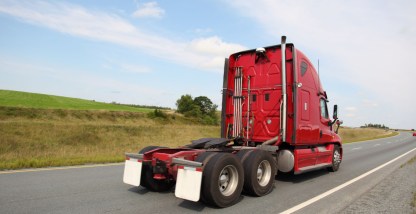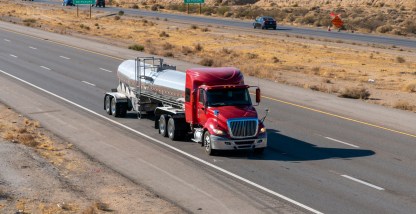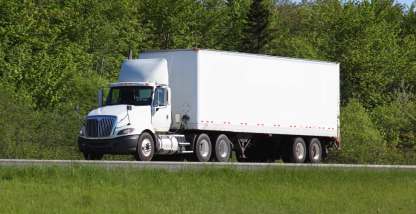- Successful owner-operators can earn a gross income of about $222,000 a year.
- In addition to a USDOT number and MC number, most owner-operators need an electronic logging device (ELD).
- You can choose to buy or lease a truck; most owner-operators get their start with lender financing on a vehicle purchase.
If you’re thinking of becoming an owner-operator, there has never been a better time. The U.S. economy’s total trade volume is on the upswing, and 2020 may continue to register positive growth in terms of the total tonnage of freight moved across the country by trucks.
In fact, the U.S. truck driver shortage is on course to double over the next decade. These trends are good indicators that it’s a great idea for you to become an owner-operator and start running your very own trucking business.
Who is an owner-operator?
An owner-operator is, to put it simply, a driver who owns their own truck. Being an owner-operator is substantially different than driving for a company; you’re now also taking on all the fleet manager responsibilities. You’re responsible for your vehicle, its upkeep and its payments. You’re also responsible for licensing, taxes and all other aspects of owning a trucking business.
Are you mentally ready to become an owner-operator?
Before anything else, you need to make an unbiased and accurate assessment of your current standing — especially of your short- and long-term goals.
Are you financially ready to run your own trucking business? Do you have a method in place for consistently closing deals? These are just some of the many questions you need to answer before deciding to become an owner-operator.
Other points for consideration are your health while on the road, your family or home time, and the adequacy of your knowledge regarding road regulations.
If you’re an experienced truck driver, that background is, of course, an advantage. According to surveys, company drivers with 3 to 5 years of truck driving experience make the best candidates for venturing out on their own.
If you believe you are the right candidate with the right combination of talent, drive, and grit, then you can begin your journey towards becoming an independent owner-operator.
What are the benefits of becoming an owner-operator?
With an average gross owner-operator income potential in excess of $222,000 per year, your trucking business is a bonanza waiting to happen for you and your family — if you play your cards right.
As with many small businesses, venturing on your own means you can create a schedule that suits your lifestyle. You can decide when to take time off, and when you should maximize your work schedule to make the most money.
As an owner-operator, you have the freedom to find and book your own loads. You’re also in charge of deciding what kinds of loads to haul and what routes to take.
How to become a successful owner-operator
Here are the first steps to get going.
1. Get your USDOT and register with the FMCSA
To become an owner-operator, you first need to acquire the USDOT and MC numbers necessary to operate legally.
The Federal Motor Carrier Safety Administration is a division of the US Department of Transportation. The FMCSA (and you’ll become very familiar with this agency) can tell you who needs a USDOT number and how to get one.
You’ll need to register with the FMCSA.
2. Obtain your trucking authority
Your next move is to secure an MC number (Motor Carrier number).
Trucking authority, overseen by the FMCSA, is what allows you to transport freight as a motor carrier.
You might hear about two carrier categories: common or contract. A common carrier can be hired by a shipper or broker. A contract carrier, on the other hand, is contracted to haul loads for a particular company and is not available to the general public. These terms are still widely used, but when it comes to your registration and other regulation compliance, the government no longer makes any distinction between the two categories.
Being in the business also requires you to be amply covered by health and truck insurance. Again, the FMCSA is a helpful resource for information.
It’s also worth pointing out that the trucking industry is heavily regulated. In fact, your seamless transition from being a truck driver to an owner-operator can easily depend on whether or not you’re complying with road regulations.
What is the ELD mandate?
In December of 2017, the ELD mandate was implemented by the FMCSA. The federal rule required non-exempt commercial motor vehicles to install FMCSA-registered electronic logging devices.
According to the FMCSA, most motor carriers and drivers who were currently required to maintain records of duty status (RODS) needed to comply with the ELD rules.
Should you lease or buy your truck?
As an independent owner-operator, your choices are clear: either buy your truck and trailer outright or acquire your assets through financing.
The majority of trucking startups take advantage of lender financing simply because we are talking about a substantial amount of money required to acquire equipment.
The best ways to fund the purchase of your truck
First, take your time looking for the best truck deal you can find, and at the same time, look for a lender with the lowest interest rates. As with all loans, you’ll get the lowest cost on financing if your credit is in good shape. If it isn’t, consider making moves to improve it.
Here are some quick tips to help your credit score:
- Pay all of your bills on time
- Pay off or take care of any accounts in collections
- Pay down existing debt
Banks are not your only source of capital. Take a look at the other financial options available to you in becoming an owner-operator. Here are a few examples.
Alternative funding sources
Captive lending institutions
Truck equipment manufacturers own these companies. They are motivated to loan money to you as a new owner-operator because they are in the business of selling trucks.
Used truck dealers may refer you to commercial lending institutions. This could be a good option because a solid second-hand unit with a powerful engine and spotless maintenance can be a good purchase for you.
Commercial lending institutions
These finance companies are not necessarily affiliated with truck manufacturers, but certain ones cater to the trucking industry.
No matter the type of financing arrangement you agree to, the interest rate you secure will either leave an unsightly dent in your finances or improve your overall profitability. Your truck monthly loan payments can take as much as 4 percent of your monthly gross revenue.
Following are some factors that can affect your financing interest rates:
- Your credit history
An excellent credit rating will help you obtain the lowest interest rates. Financial institutions look at your records to assess your credit risk.
- Permanent address
A decisive factor that will work for you is if you are a longtime resident of a specific address. A stable home address is a measure of creditworthiness.
- Stable job background
Borrowers who show a stable job history are generally classified as lower risk. Job-hopping, on the other hand, can send the wrong signal to your possible financiers.
The three factors above, and others, are considered during your credit risk review.
Because interest charges are driven by time, the shorter your loan period, the lower the cost, so aim to pay off the loan in the shortest time possible. Also, truck loans payable in 4 years or less allow you to claim tax deductions on an asset’s depreciation. Payback periods of 5 years and beyond start eating into your earnings.
How to be a profitable owner-operator
The path to your profitable trucking business isn’t complicated. In fact, your day-to-day operations can be viewed and analyzed using this linear equation:
Revenue per mile – Cost per mile = Gross revenue – Taxes = Net profit
Lower your variable costs as much as possible. There are several ways you can go about doing this:
- Find the quickest and shortest routes. It goes without saying that the shorter your route and the sooner you reach your destination, the less fuel your truck consumes.
Not only will you be able to reduce your expenses by finding the shortest route to your destination, but you’ll also be able to accommodate more deliveries and contracts, helping you grow your profits.
ELDs with a built-in GPS feature can allow you to navigate the most efficient routes to your destinations.
- Avoid severe maintenance issues. Address your vehicle’s maintenance problems as soon as you know about them — while they are still minor — before the issue becomes a full-blown maintenance disaster. And stay on top of routine maintenance.
Low tire pressure, for example, can shorten your tire life if left unchecked. Taking a moment to inflate a tire to its proper pressure can help you avoid an early replacement up the road.
Having an ELD with vehicle diagnostic features can be a huge help, as it automates vehicle maintenance so that you don’t have to keep it all in your head.
- Reduce vehicle idling. According to studies, when a truck idles for an hour, it consumes about half a gallon of fuel. When you factor in the loss of productivity together with the amount of fuel wasted, the true cost of idle time becomes even more glaring.
An ELD solution with an idle-time tracking feature that helps you see how much fuel you’re wasting because of vehicle idling so you can fix the issue — which can save you thousands of dollars every year.
- Avoid road collisions and their possible legal liabilities. Not only is your (and other motorists’) well-being put at risk, but the potential liabilities can quickly ruin a small business.
Make sure that you are doing your best to avoid possible road accidents. Installing a dash cam, like Motive’s Smart Dashcam, is a great way to show proof of what happened and mitigate any potential long, drawn-out litigation and insurance headaches. With video evidence, you may also be able to protect yourself against fraudulent claims.
The best way to use load boards to find the best loads
Another inside track to profits as an owner-operator is the use of load boards. Load boards are a fast and convenient way to find jobs on the routes on which you generally drive.
There are many options available. Here are some factors to consider, according to knowledgeable truckers:
- Cost. There are free load boards, but many cost money. It’s a good idea to find load boards that offer a free trial so you can see how good of a fit the load board will be for you.
- Interface. Choose a load board that has a user-friendly interface, so you don’t waste time trying to figure out how the board works.
- Mobile app. When you’re out on the road, you’ll need a load board that offers a mobile app, so that you’ll be able to access from your phone.
- Notifications. Choose a load board that will send notifications to your email or phone, so that you never miss out on loads.
Owner-operator is a viable career goal
With the right information, you can get the head start that you need on the path to becoming a successful, profitable owner-operator.
Good luck!







